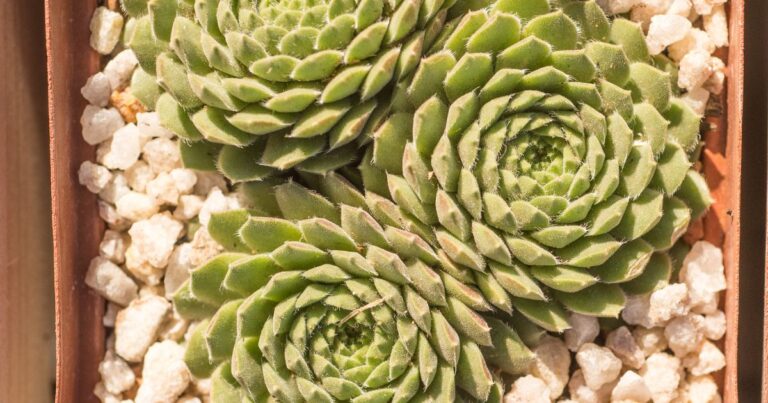How to Successfully Plant Artificial Succulents: A Step-by-Step Guide

You know I love growing succulents. So why would I use artificial succulents? There are some times when artificial succulents are the way to go. I’ll get more into that later, but for now, just know that even I, a succulent growing guru, find lots of ways to garden with artificial succulents.
If you’re looking for a no-maintenance way to add some greenery to your home, artificial succulents are a great option. Not only do they require no watering or sunlight, but they also come in a variety of shapes and sizes and many look amazingly real.

How do I successfully plant artificial succulents?
To plant artificial succulents successfully, choose arrangements that hide any signs that they’re fake, like placing them high up, intermixing them with real succulents or plants, and placing them with candles or in a terrarium.
In this article, I’ll walk you through the steps to plant artificial succulents so you can enjoy their beauty without any of the upkeep.
Want even more ideas of what to do with artificial succulents? These fairy garden ideas and mini succulent garden ideas work great with artificial succulents.
If you’re thinking of mixing real succulents into your design, make sure to learn how to take care of succulents properly.
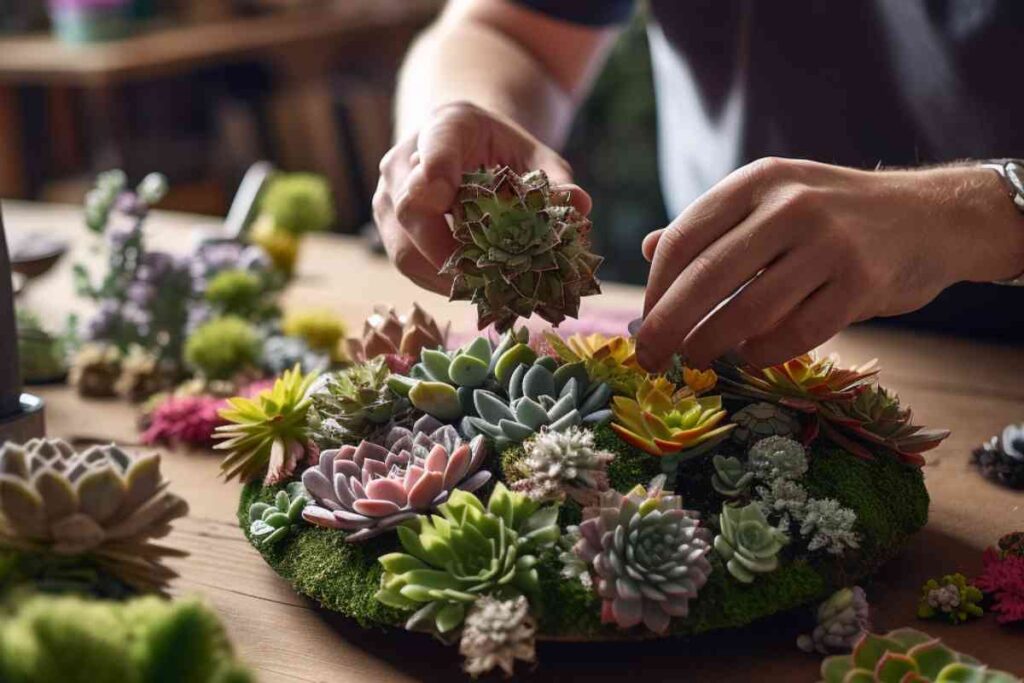
Why Use Artificial Succulents?
- In high places that are hard to reach: Artificial succulents can be placed in elevated areas where it’s difficult to water and care for live plants regularly. Since they closely resemble real succulents, people viewing from a distance are more likely to believe they’re real, creating a visually appealing display without the need for frequent maintenance.
- Weddings and other decor where live succulents aren’t practical: Live succulents may not always be practical for special events due to limited availability, transportation challenges, or the need for long-lasting arrangements. Artificial succulents provide a convenient alternative that can be prearranged and used as decorations throughout the event, maintaining their appearance without any watering or care.
- Creating visually interesting planting arrangements: Artificial succulents come in various shapes, sizes, and colors, allowing for creative and visually appealing planting arrangements. They can be combined with other artificial or live plants or decorative elements to achieve unique displays that may not be possible with live succulents alone.
- Unsuitable conditions for real succulents: Places with no natural light or unsuitable environmental conditions may not support the growth of real succulents. Artificial succulents offer a solution by providing the appearance of greenery and vibrant succulents in areas where live plants wouldn’t survive.
- Terrariums or enclosed environments: Terrariums aren’t conducive to the survival of live succulents. Artificial succulents can be used to create attractive terrarium displays without the need for natural light or regular watering, ensuring a long-lasting and low-maintenance arrangement.
- Maintaining a consistent size: Artificial succulents retain their size and shape over time, making them ideal for creating arrangements where uniformity is desired. Live succulents can grow and change in size, which may not always suit specific design preferences.
- Travel or lack of plant care skills: If you travel frequently or struggle with keeping plants alive, artificial succulents can be a great option. They require no watering, sunlight, or care, allowing you to enjoy the beauty of succulents without the worry of maintaining them.
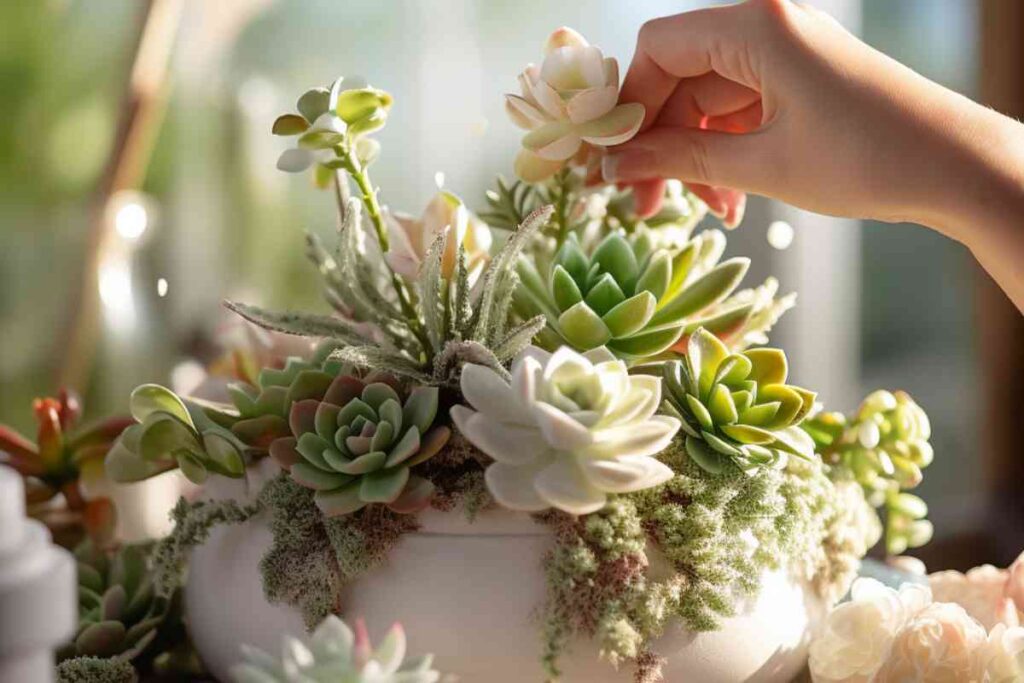
Tips for Planting Artificial Succulents
How to Attach Succulents
Super glue or hot glue are excellent options for securely attaching succulents to various surfaces. These adhesives provide a strong, invisible or hard-to-see bond, and ensure that the succulents stay in place.
If your artificial succulent display will be placed outdoors or in areas prone to humidity, such as a bathroom or kitchen, it’s recommended to use a water-tight glue or adhesive. These types of glues are designed to withstand moisture and will help prevent the succulents from detaching or being affected by humidity.
Another technique is to pin succulents into place around a foam core. This method involves using floral pins or other small, sturdy pins to secure the succulents onto a foam base. This allows for flexibility in arranging the succulents and provides a secure hold. I have a hard time making permanent decisions about my arrangements, so I like this technique.
Try Adding Some Real Succulents
Incorporating real succulents can take your display to the next level of authenticity. By combining artificial succulents with live plants that tolerate the lighting and conditions of your space, you can create a truly convincing arrangement.
Choose real succulents that are well-suited to the lighting and environmental conditions of your space. For example, Mother-in-Law’s Tongue (Sansevieria) is a popular choice as it thrives in low light and can tolerate a variety of conditions.
Arrange the real succulents alongside the artificial ones to create a seamless blend. Mix and match different varieties to add visual interest and replicate the diversity found in nature. Consider using the real succulents as focal points or clustering them in specific areas of the arrangement for an authentic touch.
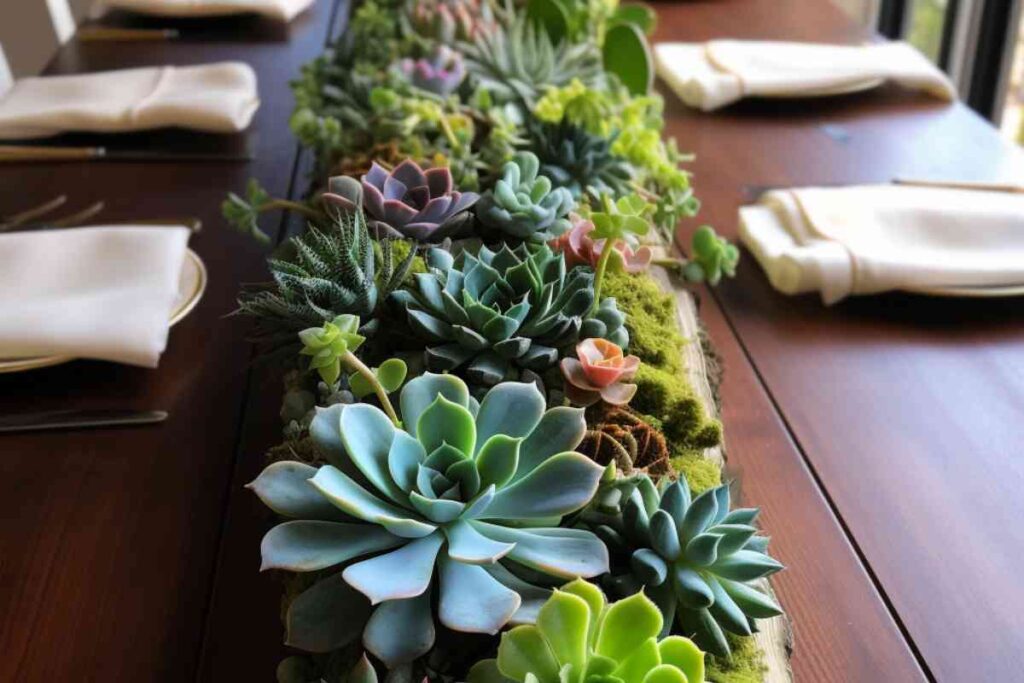
To maintain the illusion of a fully artificial display, hide the pot of the live succulent within the arrangement. Use moss, decorative elements, or carefully positioned artificial succulents to cover the pot, ensuring it blends seamlessly with the rest of the design.
Make sure the succulents are potted in well-draining soil. To ensure their health and prevent overwatering, it’s best to water them separately from the artificial succulents. Carefully remove the live plant from the display, water it as required, and allow it to drain thoroughly before placing it back into the arrangement.
Try Adding Some Real Plants that are Easy to Care For
I love succulents, but I’ll be the first to admit they’re not the easiest to care for inside. Not when you compare them to a pathos, who’s happy growing out of a glass of water with the light of a window twenty feet away. Adding some natural plants creates a unique display that will convince your friends who don’t have much of a green thumb and confuse your plant-loving guests.
Select real plants that thrive in low-light conditions and can coexist with your artificial succulents. Popular choices include Pothos (Epipremnum aureum), Philodendron, Monstera, and various fern species. Ensure that the lighting conditions in your space align with the requirements of these plants.
Some low-light plants, like Pothos and Philodendron, are adaptable to growing in pots without drainage holes. This means you can place them directly in a decorative pot within your succulent display. Use a well-draining growing medium like LECA (Lightweight Expanded Clay Aggregate) to provide adequate aeration and prevent waterlogging.
Integrate the real plants with your artificial succulents in a visually appealing manner. Consider the height, shape, and growth habit of each plant to create a balanced and dynamic display. Place trailing plants like Pothos or ferns to cascade over the edges of pots or arrange taller plants like Monstera as focal points.
Be Inspired by Nature
Look at photographs or go outside and check out some real succulents. Pay attention to the shapes, colors, textures, and growth patterns of different species. This visual research will provide inspiration and guide you in replicating natural succulent arrangements.
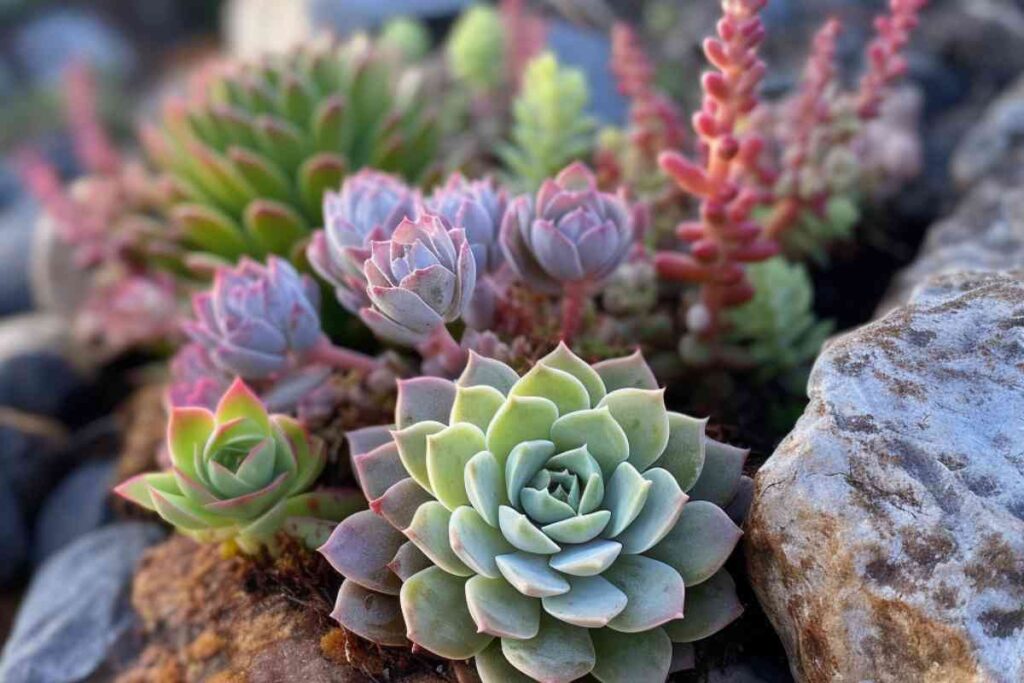
In nature, many succulents, such as Sempervivum (commonly known as “hen and chicks”), form clusters of smaller rosettes around a larger central rosette. To emulate this effect, arrange smaller artificial succulents around a larger one of the same type. Cluster them closely to mimic the natural growth habit and create a sense of unity.
Incorporate a mix of succulent types, such as trailing and upright varieties, to add visual interest and realism. This diversity mimics the competition for sunlight in a garden, where succulents may grow at different angles and orientations. The contrasting shapes and growth habits will give the impression of a dynamic and thriving succulent garden.
Ideas for Planting Artificial Succulents
Succulent Pendant
I just love succulent pendants. Whether you go the glass jar or resin route, you can be sure this is one necklace you’ll get plenty of complements on. I sure do!
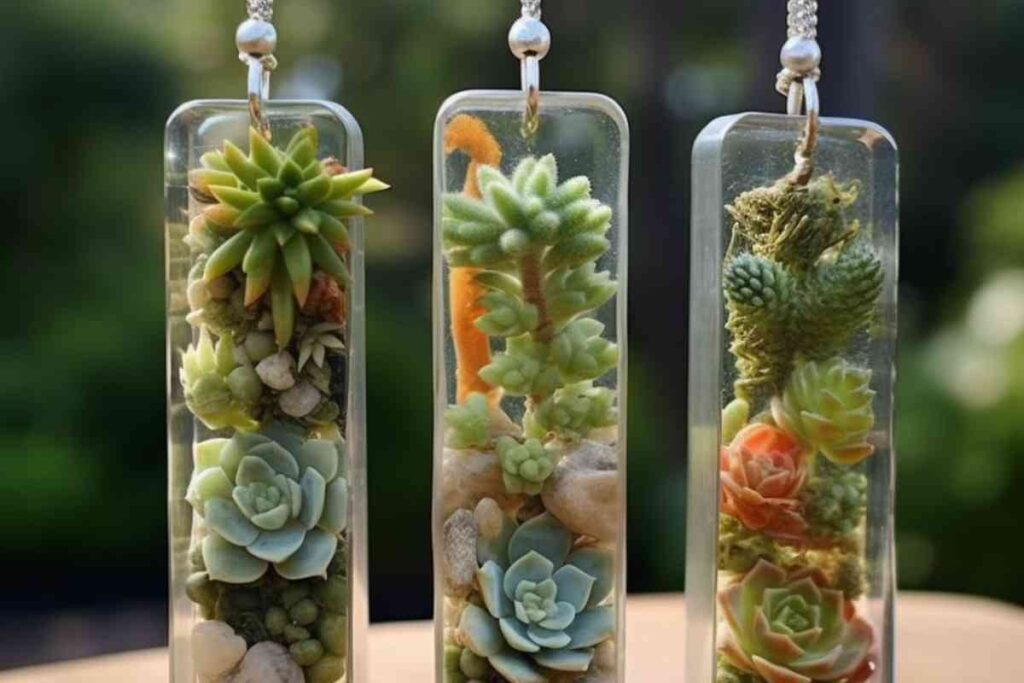
Succulent Necklace with Little Glass Jars:
- Get small glass jars with cork stoppers or tiny vials.
- Carefully insert small artificial succulents into the jars, arranging them to create an appealing composition.
- Securely close the jars with the cork stoppers.
- Attach a jump ring or small eye screw to the cork stopper.
- Thread a necklace chain through the jump ring or eye screw to create a unique and botanical-inspired necklace.
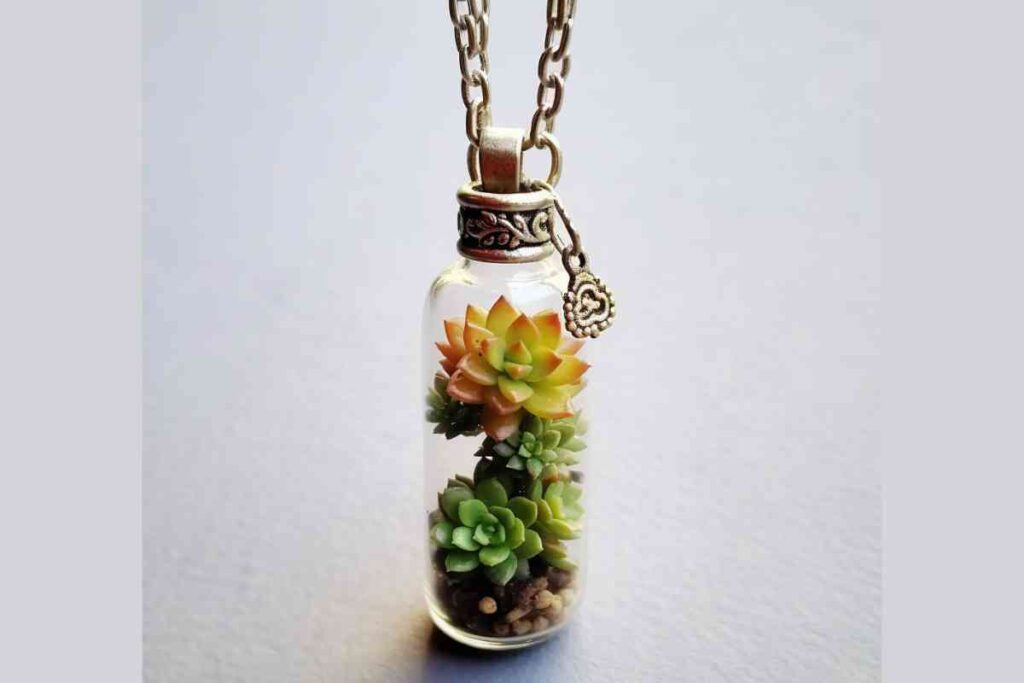
Succulent Pendant with Resin:
- Select a pendant bezel or an open-back pendant frame in the desired shape and size.
- Prepare a small amount of jewelry-grade resin according to the manufacturer’s instructions.
- Arrange artificial succulents inside the pendant frame, ensuring they fit comfortably.
- Carefully pour the resin over the succulents, making sure to completely cover them and fill the pendant frame.
- Allow the resin to cure and harden according to the manufacturer’s instructions.
- Polish the resin to a shine if necessary
- Attach a jump ring or bail to the pendant, and thread it onto a necklace chain to create a beautiful succulent pendant necklace.
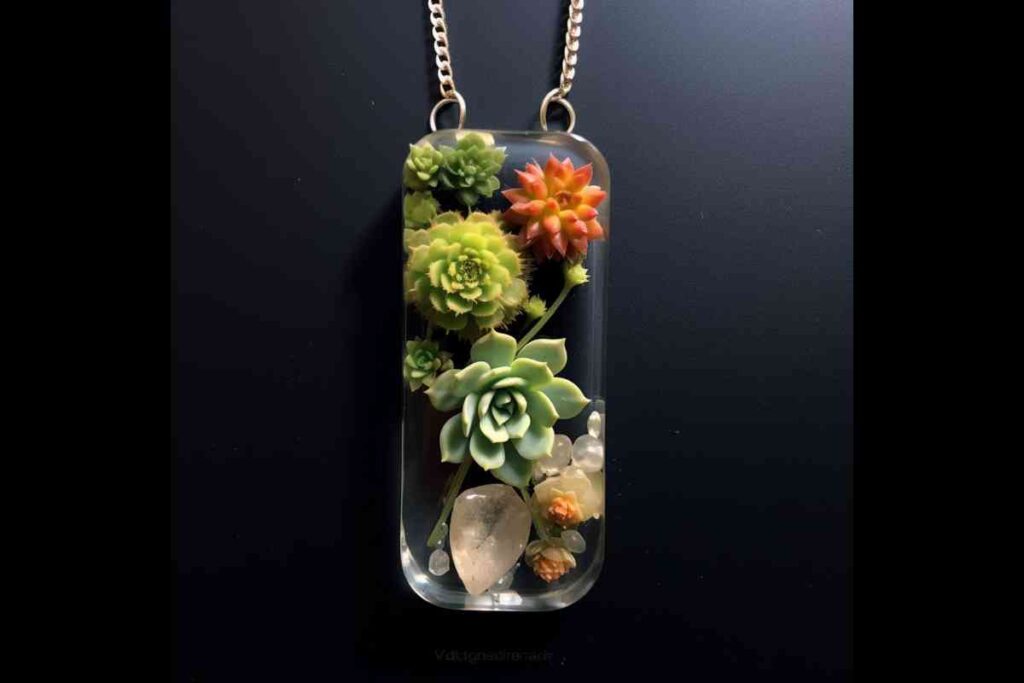
Succulent Earrings
Creating artificial succulent earrings is so much fun, as well as a stylish and unique accessory. Here’s a step-by-step guide on how to make them:
Materials you’ll need:
- Artificial succulents of suitable size for earrings
- Earring studs or earring hooks
- Jump rings (if using earring hooks)
- Jewelry pliers
- Glue (if attaching directly to earring studs)
- Decorative chains (if making dangle earrings)
- Optional: Small beads, charms, or decorative elements for added flair
For stud earrings:
- Prepare the succulents: Trim any excess stems from the artificial succulents, creating a flat base for attachment.
- Attach the succulents: Apply a small amount of glue to the flat base of the artificial succulent and carefully press it onto the earring stud. Hold it in place until the glue dries and the succulent is securely attached.
- Allow the glue to cool and set: Give the glued earrings sufficient time to cool and set, ensuring the succulents are firmly attached to the earring studs.
- Finishing touches: Once the glue has completely dried, inspect the earrings and make any necessary adjustments. Ensure that the succulents are centered and securely attached to the earring studs.
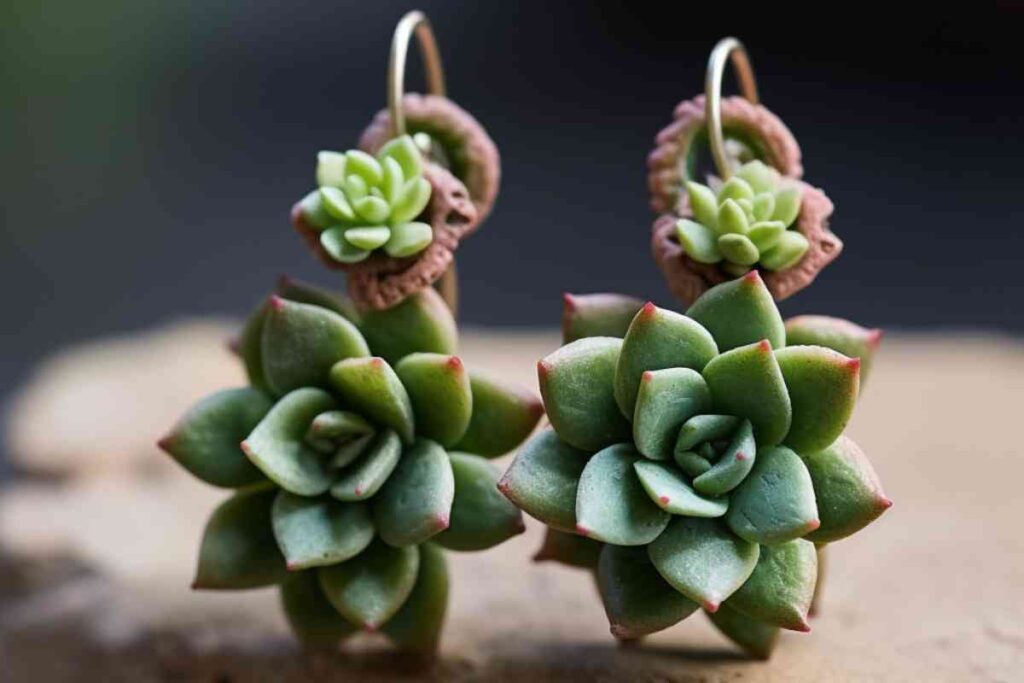
For dangle earrings:
- Prepare the succulents: Trim any excess stems from the artificial succulents, creating a flat base for attachment.
- Attach the succulents to chains: Using small jump rings and jewelry pliers, attach the artificial succulents to a short decorative chain. Open a jump ring using the pliers, slide it through the base of the succulent, and then attach it to the chain. Close the jump ring securely.
- Attach earring hooks: If your chains don’t have pre-attached earring hooks, use jump rings to connect the top of the chains to earring hooks. Open a jump ring, slide it through the end of the chain, and then attach it to the earring hook. Close the jump ring securely.
- Finishing touches: Inspect the earrings and make any necessary adjustments. Ensure that the succulents are hanging evenly and securely from the chains.
Artificial Succulent “Living” Wall
Living walls are all the rage right now, but let’s be honest, they’re not easy to make or keep up. Watering, repotting, and pruning all get more complicated when you go vertical. None of that is a problem with this “living” wall!

Materials you’ll need:
- Artificial succulents of various sizes, colors, and textures. Make sure to choose some that dangle, like burro’s tail or string of pearls.
- A large, sturdy backing material (such as plywood, foam board, or mesh grid)
- Wire cutters
- Floral adhesive or hot glue gun
- Command strips or wall mounts
- Optional: Moss, preserved moss, or decorative elements for added texture and variety
Step-by-step process:
- Prepare the backing material: Cut the backing material to the desired size and shape for your succulent wall. Ensure that it is sturdy enough to support the weight of the artificial succulents.
- Plan the arrangement: Before attaching the succulents, plan the placement and arrangement on the backing material. Consider the colors, shapes, and sizes of the succulents to create an aesthetically pleasing composition.
- Trim the stems: If your artificial succulents come with long stems, use wire cutters to trim them to a suitable length. You want the succulents to be flush with the backing material.
- Attach the succulents: Apply floral adhesive or use a hot glue gun to secure the artificial succulents onto the backing material. Press them firmly and hold them in place until the adhesive dries or the glue sets.
- Add variety and texture: For added visual interest, consider incorporating different types of succulents, moss, or other decorative elements into the design. These elements can be glued in place alongside the succulents.
- Allow the adhesive to dry: Ensure that the adhesive or glue has completely dried and cured before moving or hanging the artificial succulent wall.
- Hang the wall: Depending on the weight and size of the artificial succulent wall, use appropriate wall mounts, such as Command strips or other hanging systems, to securely attach it to the desired wall.
- Finishing touches: Once the artificial succulent wall is hung, take a step back and make any necessary adjustments to the arrangement. Ensure that all the succulents are securely attached and that the overall design looks visually balanced.
Artificial Succulent Mobile
I love succulents, so why shouldn’t my baby get to enjoy them too? This mobile is the perfect touch of greenery for the nursery.
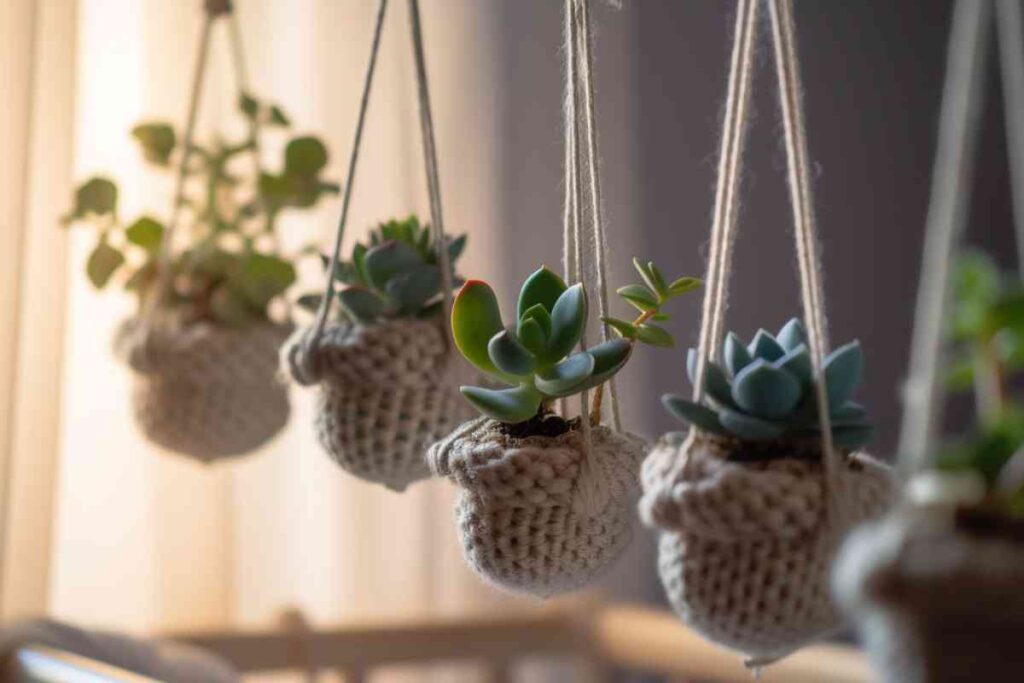
Materials you’ll need:
- Artificial succulents of various sizes, colors, and textures
- Wooden or metal hoop or embroidery hoop
- Fishing line or thin transparent string
- Scissors
- Needle or hot glue gun
- Optional: Decorative elements like beads, feathers, or ribbons
Step-by-step process:
- Prepare the succulents: Trim any excess stems from the artificial succulents, creating a flat base for attachment.
- Plan the arrangement: Lay out the succulents and other decorative elements to plan the arrangement and determine the spacing between each piece.
- Attach fishing line or string to the hoop: Cut several pieces of fishing line or thin transparent string to desired lengths, ensuring they are long enough to suspend the succulents from the hoop. Attach one end of each piece to the hoop, evenly spaced around its circumference. You can tie knots or use a needle to thread and secure the strings.
- Attach the succulents: Using a needle or hot glue gun, carefully attach the artificial succulents to the other end of each piece of fishing line or string. Ensure they are securely fastened.
- Add decorative elements: If desired, incorporate additional decorative elements like beads, feathers, or ribbons by attaching them to the fishing line or string at various intervals along the mobile. Be creative and experiment with different combinations.
- Create a hanging loop: Cut a longer piece of fishing line or string and attach it to the top of the hoop, forming a loop to hang the mobile from. Ensure it is securely attached.
- Finishing touches: Once you have attached all the succulents and decorative elements, step back and adjust the positioning of each piece to achieve a balanced and visually pleasing arrangement.
- Hang the mobile: Find a suitable location to hang your artificial succulent mobile. You can use a hook or ceiling mount to suspend it, ensuring it is secure and can freely rotate.
Artificial Succulent Table Centerpiece or Runner
This table runner will stun your friends, but unlike a real succulent table runner, you can just stash it in a cabinet between parties.
Creating an artificial succulent table runner can add a unique and botanical touch to your table decor. Here’s a step-by-step guide to help you make one:
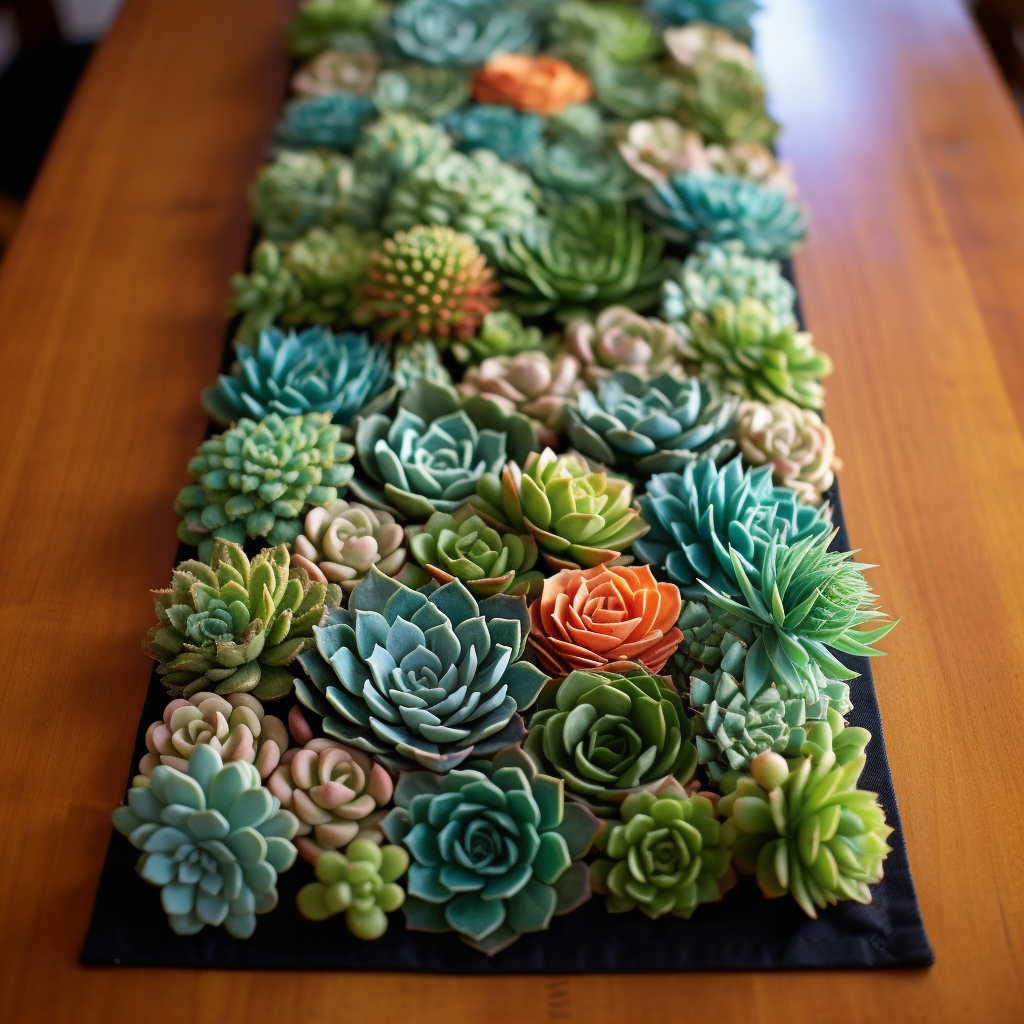
Materials you’ll need:
- Artificial succulents of various sizes, colors, and textures
- Sturdy support material (such as wood or foam)
- Glue
- Scissors
- Optional: Moss, preserved moss, or decorative elements for added texture and variety
Step-by-step process:
- Prepare the support material: Decide on the size and shape of your table runner and cut the sturdy support material accordingly. You can use wood as a visible support for a rustic look, or foam for a completely covered appearance. Choose flat foam if you want a runner that lies flat with the table
- Plan the arrangement: Lay out the artificial succulents on the support material to plan the arrangement. Consider the colors, textures, and sizes of the succulents to create an appealing composition.
- Attach the succulents: Carefully attach the artificial succulents to the support material. Apply a generous amount of hot glue to the base of each succulent and press it firmly onto the support material. Make sure the succulents are securely attached.
- Add variety and texture: For added visual interest, consider incorporating different types of succulents, moss, or other decorative elements into the design. These elements can be glued in place alongside the succulents to create a more dynamic and textured table runner.
- Cover the support material (if desired): If you’re using foam as the support material and prefer a completely covered appearance, you can glue preserved moss or faux moss sheets onto the foam to conceal it entirely. This will create a lush and natural look.
- Finishing touches: Once you have attached all the succulents and any additional decorative elements, step back and make any necessary adjustments to the arrangement. Ensure that all the succulents are securely attached and that the overall design looks visually balanced.
- Place it on your table: Lay your artificial succulent table runner on your table as a decorative centerpiece or as a runner along the length of the table. Adjust the position and alignment as needed.
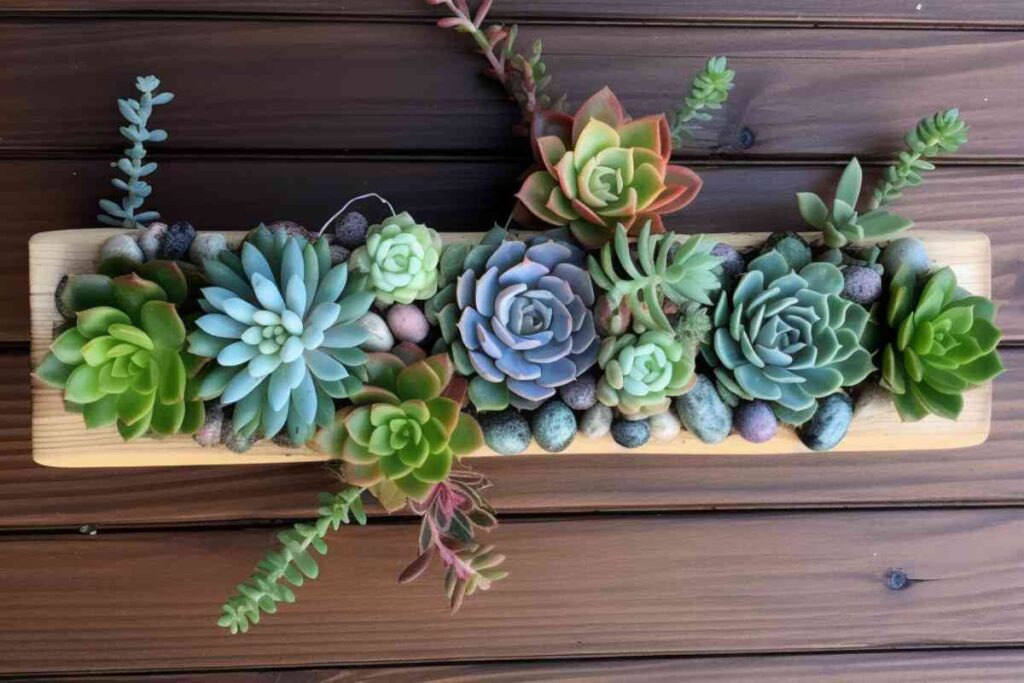
Artificial Succulent Terrarium
Real succulents struggle to survive in terrariums, but artificial succulents are PERFECT for this kind of display.
Materials you’ll need:
- Glass terrarium or container with a lid
- Artificial succulents of various sizes, colors, and textures
- Decorative sand or pebbles
- Preserved moss or faux moss
- Glue
- Optional: Small decorative elements like rocks, seashells, or figurines
Step-by-step process:
- Prepare the terrarium: Choose a glass terrarium or container with a lid that suits your desired size and style. Ensure it is clean and dry before starting the assembly.
- Create the base layer: Start by adding a layer of decorative sand or pebbles. You can create ribbons or patterns of different colored sand for an appealing effect.
- Arrange the succulents: Plan the placement and arrangement of your artificial succulents inside the terrarium. Consider the heights, colors, and textures to create an attractive composition. Play with different combinations until you are satisfied with the arrangement.
- Attach to support? You may be able to just set the succulents in the sand, but it may be best to attach them to something that can be set into the terrarium so they’re positions can be more precisely chosen. I like something natural like a rock or a piece of wood, but foam would work great too.
- Add moss and additional elements: Enhance the terrarium’s visual appeal by adding preserved or faux moss around the succulents. This adds a natural and textured element to the design. You can also incorporate small decorative elements like rocks, seashells, or figurines to personalize your terrarium further.
- Adjust and finalize: Take a step back and assess the overall arrangement. Make any necessary adjustments to the position and angle of the succulents and decorative elements.
Artificial Succulent Wreath
Welcome people to your home in style with this gorgeous wreath that’s perfect for every season and never needs watering.
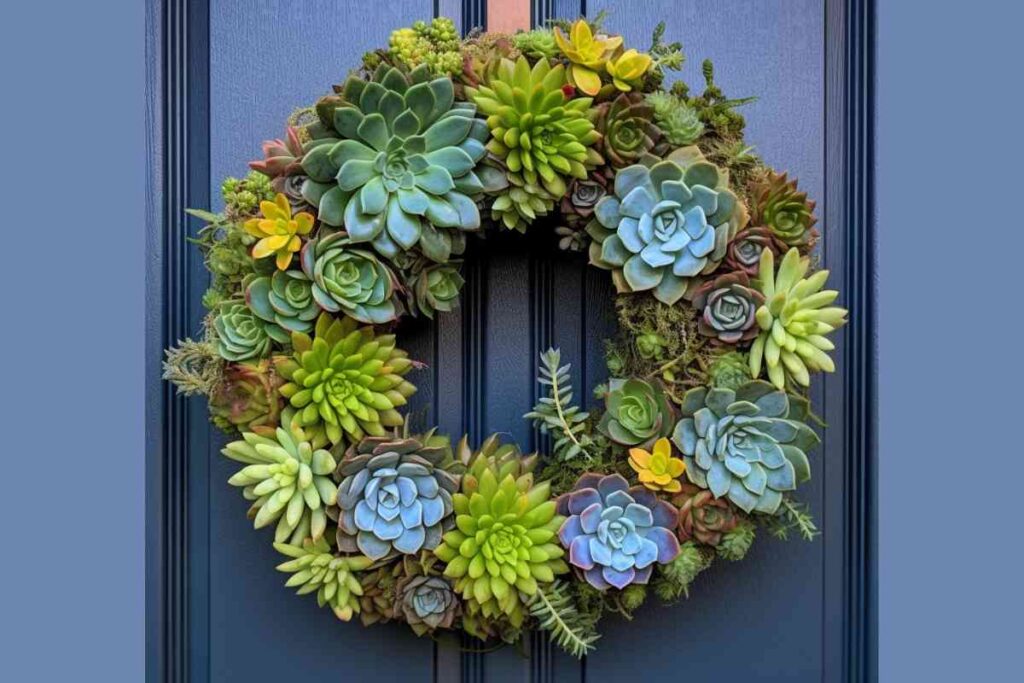
Materials you’ll need:
- Artificial succulents of various sizes, colors, and textures
- Wreath form (such as a foam or wire wreath frame)
- Floral wire or glue
- Wire cutters
- Decorative ribbon or twine (for hanging)
- Optional: Moss, preserved moss, or other decorative elements for added texture and variety
Step-by-step process:
- Prepare the wreath form: If using a foam wreath form, leave it as is. If using a wire wreath frame, consider covering it with preserved or faux moss to create a natural and textured base.
- Plan the succulent placement: Lay out the artificial succulents on the wreath form to plan the arrangement. Consider the colors, textures, and sizes of the succulents to create a visually pleasing composition. Play around with different placements until you are satisfied.
- Attach the succulents: Use floral wire or a hot glue gun to attach the artificial succulents to the wreath form. If using floral wire, wrap it around the stem or base of each succulent and secure it to the wreath form. If using glue, apply a small amount of glue to the base of each succulent and press it firmly onto the wreath form. Make sure the succulents are securely attached.
- Fill in gaps and add variety: As you attach the succulents, ensure that the wreath form is well-covered. Fill in any gaps with smaller succulents or additional decorative elements like moss or other foliage. This will create a fuller and more visually appealing wreath.
- Secure the hanging mechanism: Attach a decorative ribbon or twine to the top of the wreath for hanging. Make a loop and either tie it securely to the wreath form or use floral wire to attach it
Artificial Succulent Teacup
Creating a succulent arrangement in a teacup can be a charming and unique way to showcase these beautiful plants. Here’s a step-by-step guide to help you make one:
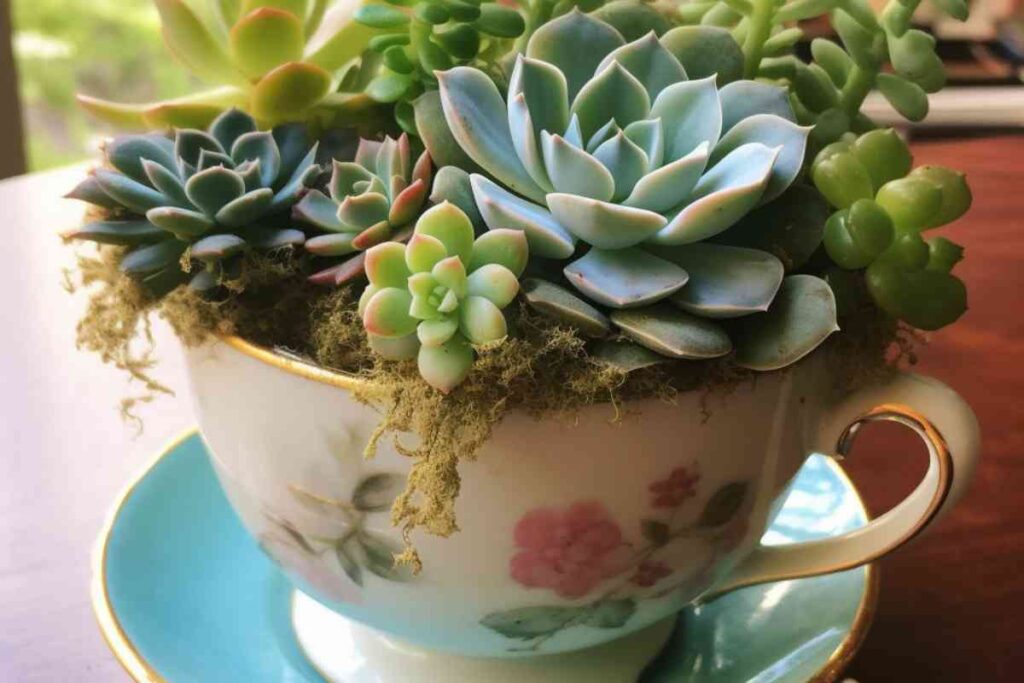
Materials you’ll need:
- Teacup or small container
- Artificial succulents of various sizes, colors, and textures
- Floral foam and pins or glue
- Scissors
- Optional: Decorative elements like moss, small rocks, or miniature figurines
Step-by-step process:
- Choose a teacup: Select a teacup or small container that complements the size and style of your succulents. Ensure that it has enough depth to hold the floral foam or accommodate the length of succulent stems.
- Prepare the teacup: If you’re using floral foam, cut it to fit the size of your teacup. Soak the foam in water for a few minutes until it becomes saturated. If you prefer to use a hot glue gun, skip to step 4.
- Insert the floral foam: Place the soaked floral foam inside the teacup, ensuring a snug fit. This will serve as a stable base to anchor the succulents.
- Arrange the succulents: Lay out the artificial succulents on a flat surface to plan the arrangement. Consider the colors, shapes, and sizes of the succulents to create an appealing composition.
- Attach the succulents: There are two methods to attach the succulents to the teacup: using floral foam or hot glue.
- Floral foam method: Pierce the stems of the succulents into the soaked floral foam, arranging them according to your desired design. The foam will hold the succulents securely in place.
- Glue method: Apply a small amount of glue to the base of each succulent and press it firmly onto the teacup or floral foam. Hold it in place for a few seconds until the glue cools and the succulent is securely attached.
- Add decorative elements: If desired, incorporate decorative elements like moss, small rocks, or miniature figurines to enhance the visual appeal of the arrangement.
Artificial Succulent Mounted on Wood
Creating an artificial succulent mounted on wood can be a wonderful way to showcase these plants as a centerpiece or wall decor. The natural look of the wood makes the succulents look more convincing.
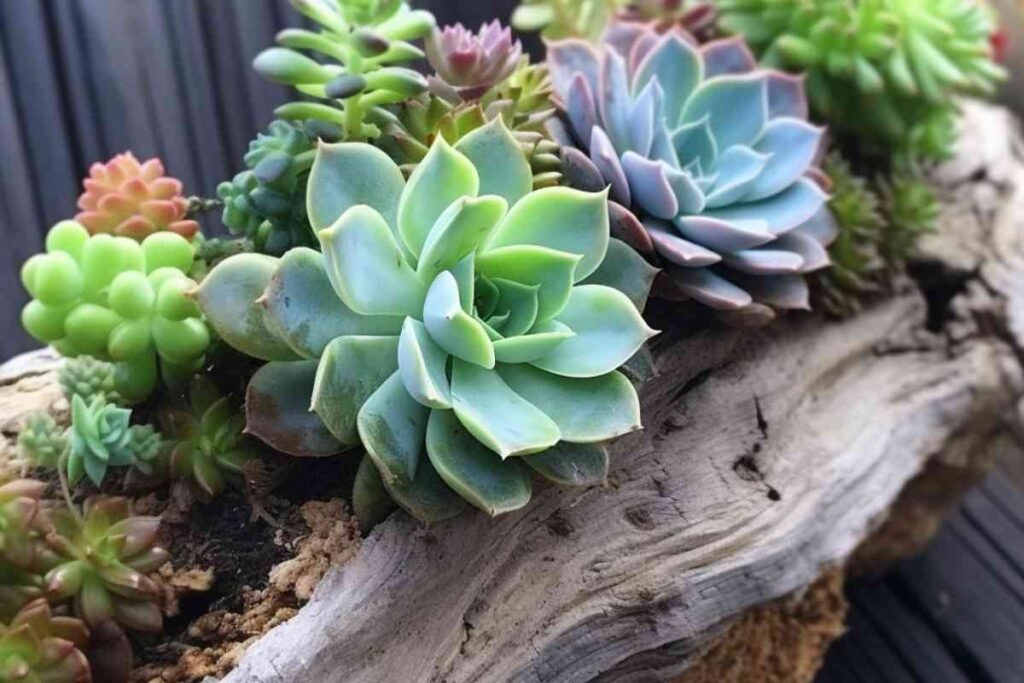
Materials you’ll need:
- Piece of wood (desired size and shape)
- Artificial succulents of various sizes, colors, and textures
- Glue or pins
- Wire or hanging hardware (if mounting on a wall)
- Optional: Decorative elements like preserved moss, small rocks, or driftwood
Step-by-step process:
- Select the wood: Choose a piece of wood that suits your desired size and style. You can use a natural wooden slice, reclaimed wood, or any other type of wood that appeals to you. Ensure that it is sturdy and free from any damage or splinters.
- Plan the succulent placement: Lay out the artificial succulents on the wood to plan the arrangement. Play around with different placements until you are satisfied.
- Attach the succulents: There are two methods to attach the succulents to the wood: pins or hot glue.
- Pins method: If your chosen wood is soft enough, you can pin succulents directly into place. You can move succulents around when you like using this tactic.
- Glue method: Apply a small amount of glue to the base of each succulent and press it firmly onto the wood. Hold it in place for a few seconds until the glue cools and the succulent is securely attached. This method offers a more permanent attachment.
- Mounting on a wall (optional): If you want to hang the succulent wood piece on a wall, attach wire or hanging hardware to the back of the wood. Ensure it is securely fastened to support the weight of the wood and succulents. Follow proper wall-mounting guidelines and use appropriate hardware for your specific wall type
Artificial Succulent Candle Display
Creating an artificial succulent and candle dish is a wonderful way to combine the beauty of succulents with the warm ambiance of candlelight. While you can do this with real succulents, it’s much easier with fake ones.
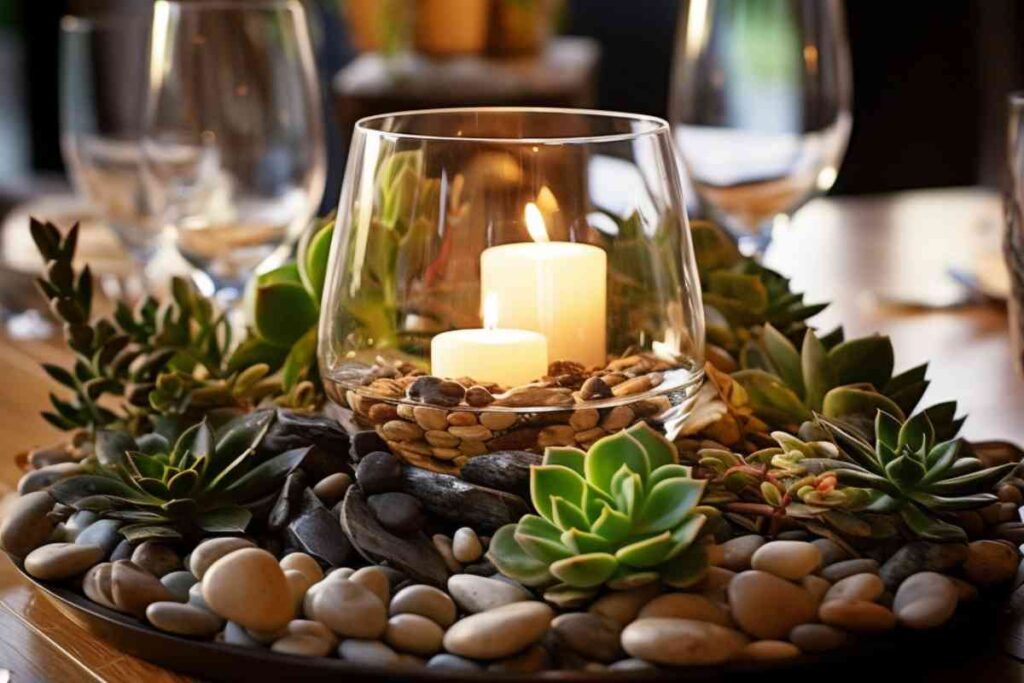
- Select a suitable dish: Choose a shallow dish or tray that complements your aesthetic preferences. Ensure that it is wide enough to accommodate both the artificial succulents and the candles comfortably.
- Prepare the base: Fill the dish with a layer of decorative gravel or pebbles. This not only provides a stable foundation but also adds visual interest to the arrangement.
- Position the succulents: Arrange the artificial succulents in the dish, nestling them into the gravel. Create an aesthetically pleasing arrangement by varying the heights and spreading them out evenly. Consider clustering different types of succulents together for an attractive visual contrast.
- Place the candles in glass holders: To ensure safety and prevent the candles from melting or damaging the succulents, use glass holders for the candles. The glass will insulate the heat and maintain a safe distance between the flame and the faux plants. Position the candles at desired intervals within the dish, allowing them to become an integral part of the overall design.
- Nestle the candles into the gravel: Gently press the glass holders into the gravel, ensuring they are secure and stable. Nestling the candles among the artificial succulents and gravel adds a captivating and harmonious touch to the arrangement.
- Finishing touches: Add additional decorative elements like moss, small pebbles, or tiny figurines to enhance the charm and personalize the arrangement further.
Conclusion
There’s no shame in loving artificial succulents. The geometric shape and unique structure of these plants lends them well to being replicated, and there are some very good succulent imitations out there. Choose succulents you love, arrange them with care, and have something you’ll treasure forever.
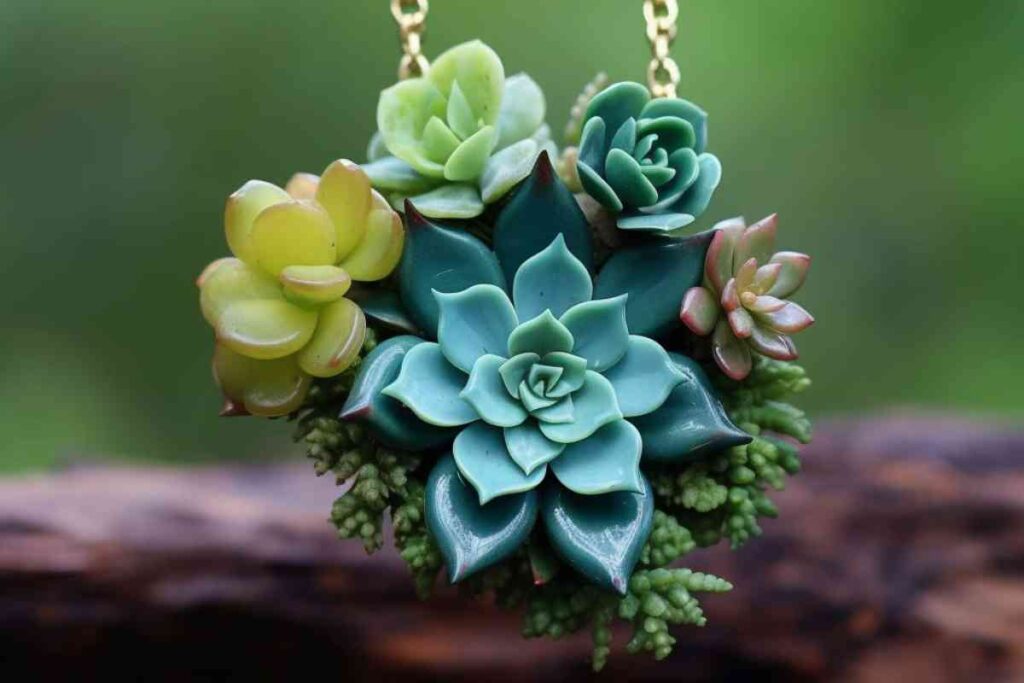
A hanging terrarium is a superb way to showcase your artificial succulents. With a little bit of height and obstruction of your view through the glass, nobody will know the succulents aren’t real.
My article on hanging terrariums is mostly about how to keep real succulents alive in them, but there’s also some great information about succulent design ideas that work well for artificial succulents.
Love the idea of a succulent table arrangement? Here are some designs that’ll blow your mind.

